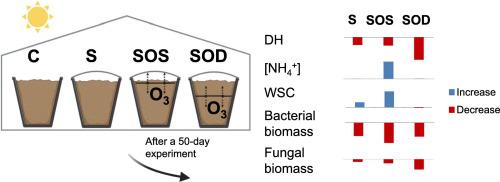Science of the Total Environment ( IF 8.2 ) Pub Date : 2020-12-04 , DOI: 10.1016/j.scitotenv.2020.143950 Marta Díaz-López , Emilio Nicolás , Rubén López-Mondéjar , Lucas Galera , Isabel Garrido , José Fenoll , Felipe Bastida

|
Pesticides have been used extensively in agriculture to control pests and soil-borne diseases. Most of these pesticides can persist in soil in harmful concentrations due to their intrinsic characteristics and their interactions with soil. Soil solarization has been demonstrated to enhance pesticide degradation under field conditions. Recently, ozonation has been suggested as a feasible method for reducing the pesticide load in agricultural fields. However, the effects of ozonation in the soil microbial community have not been studied so far. Here, we evaluate the combined effects of solarization and ozonation on the microbial community of a Mediterranean soil. For this purpose, soil physico-chemical characteristics and enzyme activities and the biomass (through analysis of microbial fatty acids) and diversity (through 16S rRNA and ITS amplicon sequencing) of soil microbial communities were analyzed in a 50-day greenhouse experiment. The degradation of the pesticides was increased by 20%, 28%, and 33% in solarized soil (S), solarized soil with surface ozonation (SOS), and solarized soil with deep ozonation (SOD), respectively, in comparison to control (untreated) soil. Solarization and its combination with ozonation (SOS and SOD) increased the ammonium content as well as the electrical conductivity, while enzyme activities and soil microbial biomass were negatively affected. Despite the biocidal character of ozone, several microbial populations with demonstrated pesticide-degradation capacity showed increases in their relative abundance. Overall, the combination of solarization plus ozone did not exacerbate the effects of solarization on the soil chemistry and microbial communities, but did improve pesticide degradation.
中文翻译:

臭氧混合和日光化结合从土壤中去除农药:对土壤微生物群落的影响
农药已在农业中广泛用于控制害虫和土壤传播的疾病。这些农药中的大多数由于其固有特性及其与土壤的相互作用,可以以有害浓度残留在土壤中。事实证明,土壤日晒可增强田间条件下的农药降解。近来,已提出臭氧化作为减少农业领域中农药负荷的可行方法。然而,迄今为止,还没有研究臭氧化对土壤微生物群落的影响。在这里,我们评估了日晒和臭氧化对地中海土壤微生物群落的综合影响。以此目的,在一个为期50天的温室实验中,分析了土壤微生物群落的土壤理化特性和酶活性以及生物量(通过微生物脂肪酸分析)和多样性(通过16S rRNA和ITS扩增子测序)。与对照相比,在日光化土壤(S),表面臭氧化(SOS)的日光化土壤和深臭氧化(SOD)的日光化土壤中,农药的降解分别增加了20%,28%和33%未经处理的土壤。日晒及其与臭氧化的结合(SOS和SOD)增加了铵含量以及电导率,而酶活性和土壤微生物量却受到不利影响。尽管臭氧具有杀菌作用,几个显示出农药降解能力的微生物种群的相对丰度增加。总体而言,日晒和臭氧的结合并没有加剧日晒对土壤化学和微生物群落的影响,但确实改善了农药的降解。











































 京公网安备 11010802027423号
京公网安备 11010802027423号